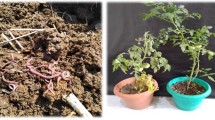Abstract
Fluopicolide, a relatively new fungicide is used for control of downy mildew of grape. Persistence study of fluopicolide was carried out on grape berries following treatment of the combination product, fluopicolide 4.44% + fosetyl aluminium 66.7% (Profiler 71.14 WG) at the recommended and double the recommended dose of 2.5 and 5.0 kg ha−1. Four treatment sprays were given at 15 day intervals, starting from 1 month after pruning of the vines. Residues of fluopicolide in grape berries were estimated on 0 (1 h), 1, 3, 5, 7, 10, 15, 20, 25, 30 day and at harvest (64 days after the last spray application). The initial residue deposits of fluopicolide on grape berries were 0.58 and 1.32 mg kg−1 from treatment at the recommended and double dose, respectively. Dissipation of fluopicolide residues was a slow process. After 30 days of treatment, 0.068 and 0.204 mg kg−1 of residues still remained in the berries from treatment at the recommended and double dose, respectively. Fluopicolide residues in grape berries dissipated with the half-life of 10.2 and 12.3 days. Residues in grape berries and soil at harvest were below the quantifiable limit of 0.01 mg kg−1 from both the treatments.


Similar content being viewed by others
References
Anonymous (2005) Crop protection monthly, UK. 191. Accessed 15 July 2010
Anonymous (2006) Grape profile. http://nrcgrape.nic.in/zipfiles/GRAPE%20PROFILE%20-%20NRC%20Grapes.pdf. Accessed 14 July 2010
Anonymous (2007) United States Environmental Protection Agency, Pesticide Fact Sheet. http://www.epa.gov/opprd001/factsheets/fluopicolide.pdf. Accessed 15 July 2010
Anonymous (2009) Joint meeting on pesticide residues: fluopicolide, pesticide residues in food. FAO plant production and protection paper 235: 350–406
Cooke LR, Little G (2006) Evaluation of fluopicolide-containing formulations for the control of potato late blight in Northern Ireland. Pflanzenschutz-Nachrichten-Bayer 59:303–316
Gouot JM (2006) Field efficacy of profiler, a fluopicolide and fosetyl-Al fungicide combination for the control of grape downy mildew (Plasmopara viticola). Pflanzenschutz-Nachrichten-Bayer 59:293–302
Rekanovic E, Potocnik I, Stepanovic M, Milijasevic S, Todorovic B (2008) Field efficacy of fluopicolide and fosetyl-Al fungicide combination (Profiler®) for control of Plasmopara viticola in grape vine. Pestic Phytomed (Belgrade) 23:183–187
Acknowledgments
The authors thank Director, IIHR Bangalore for providing the facilities to carry out this study and ICAR, New Delhi for sponsoring the study.
Author information
Authors and Affiliations
Corresponding author
Rights and permissions
About this article
Cite this article
Mohapatra, S., Ahuja, A.K., Deepa, M. et al. Persistence and Dissipation of Fluopicolide in/on Grape Berries and Soil Under Semi Arid Tropical Climatic Conditions of India. Bull Environ Contam Toxicol 86, 238–241 (2011). https://doi.org/10.1007/s00128-011-0193-3
Received:
Accepted:
Published:
Issue Date:
DOI: https://doi.org/10.1007/s00128-011-0193-3




